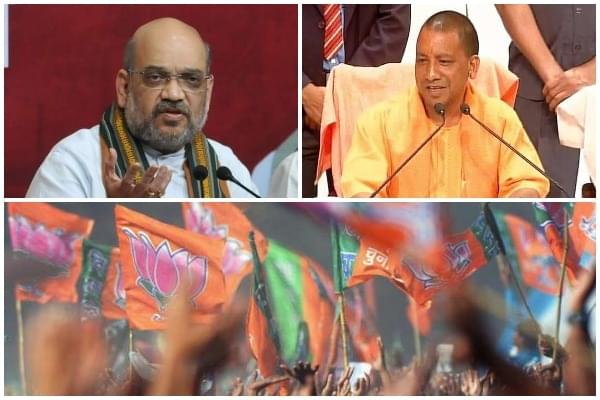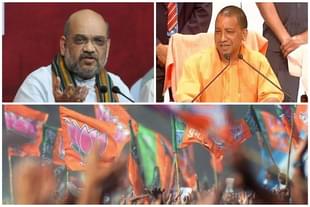Politics
Shah And Adityanath Are Forcing The Kerala Left To Choose Between The Hindu Vote And Hindu-Bashing
R Jagannathan
Oct 05, 2017, 01:29 PM | Updated 01:29 PM IST
Save & read from anywhere!
Bookmark stories for easy access on any device or the Swarajya app.


Bharatiya Janata Party (BJP) president Amit Shah is clearly upping the ante against the Communist Party of India Marxist (CPI-M)-led Left Democratic Front (LDF) in Kerala. After launching a 14-day “Jan Raksha Yatra” to highlight the Left’s murderous politics in the state, he charged the Chief Minister, Pinarayi Vijayan, with being directly responsible for the killings of BJP and Rashtriya Swayamsevak Sangh (RSS) workers. "The bloodstains of more than 120 BJP and RSS workers killed in political violence in Kerala are on your (Vijayan's) clothes. You are directly responsible for the killing of CPI-M's opponents," Shah was quoted by The Times of India as saying at the beginning of the yatra on 3 October.
With the BJP’s Hindutva icon, the saffron-clad Yogi Adityanath, also being conscripted into the fight, it is clear that Shah is pulling out all the stops to expose the chinks in the CPI-M’s armour.
Shah believes, and he is probably right, that the Left’s vulnerability is the Hindu vote, currently the Left’s mainstay in Kerala politics. He is trying to drive the CPI-M’s internal contradictions, where the party leadership is essentially anti-Hindu in terms of posture, and its cadre, which is largely Hindu, to breaking point. Put simply, the CPI-M will have to choose between being a Hindu-baiting party, which is a national sport among so-called secular parties, and asserting its core Hindu vote.
How did this happen to a communist party? It was largely by default. As communists, both CPI-M and CPI are supposed to be atheists or irreligious, with the focus being on class consolidation, not communal polarisation. But in Kerala, its opponent so far has been the United Democratic Front (UDF), which is essentially a coalition of minority communal parties led by the Congress, the Indian Union Muslim League and the Kerala Congress. In the UDF, power has shifted to Muslim and Christian parties, and Hindu voices remain muted, despite the Congress being in the lead role. The last Congress chief minister, Oommen Chandy, was a Christian.
It is the UDF’s composition that probably pushed Hindus, especially the Ezhavas, into the arms of the CPI-M, as a form of counter-polarisation. At various points over the last few decades, the LDF has flirted with smaller Muslim communal organisations, but its core vote is Hindu.
There are demographic reasons for this, too. In both Kerala and West Bengal, where the Left Front has ruled the roost for long, Hindus face the prospect of being demographically marginalised over the next few decades. In Kerala, the Hindu population is around 54 per cent, while Muslims have been increasing their shares in every decade through higher birth rates. Christian proportions have been stagnant, but their true numbers are difficult to fathom because many converts from Hinduism do not formally declare themselves as Christian for fear of losing reservation benefits. In West Bengal, thanks to illegal immigration and high birth rates, Muslims are gaining on Hindus.
In Kerala, the Muslim share between 2001 and 2011 rose from 24.7 per cent to 26.6 per cent, and in West Bengal from 25.2 per cent to 27 per cent. The situation is most dire in Kerala, where Muslims and Christian together form a solid 45 per cent of the population. Given current demographic trends, it is only a matter of time before Hindus fall below 50 per cent.
The BJP and the Left are locked in a violent conflict, largely prompted by the latter, because their core vote base is the same in Kerala. If the BJP gains, the CPI-M loses. As long as the BJP was not a factor in Kerala politics, a larger chunk of the Hindus went to the LDF by default. Now that there is a more visible claimant to the Hindu identity, the Left sees a threat to its existence. Hence its panic-driven descent into violence to stem future losses.
Having got the Hindu vote largely by default due to the UDF’s positioning as a minority aggregation, the CPI-M now has a difficult choice to make. It cannot retain its Hindu vote in Kerala (or, for that matter, in West Bengal) if its leadership does not formally abandon its Hindu-baiting stance at the national and regional levels.
The current Left leadership and its intellectuals have let down their Hindu voter base, and it is no surprise that the BJP is looking to gain from this disenchantment between the top and the base. One has to only read Arun Shourie’s Eminent Historians, and Meenakshi Jain’s The Battle for Rama, to understand the key role played by Left intellectuals and historians in scuttling Hindu interests in the name of “secularism”.
The Left has two options: it can either choose to be true to its ideology and focus on class, and remain neutral, and even play a peace-maker, when Hindu and minority interests come in conflict. Or it can assert its Hindu identity, without scuttling the interests of the minority communities. What it cannot do is to retain the Hindu vote by regularly targeting Hindus by its bogus secularism, or by killing off political foes in the BJP and RSS, who have as much claim to represent Hindu interests as the Left.
The Left’s existential crisis will end once it realises the folly of irritating its core voter base.
Jagannathan is former Editorial Director, Swarajya. He tweets at @TheJaggi.





